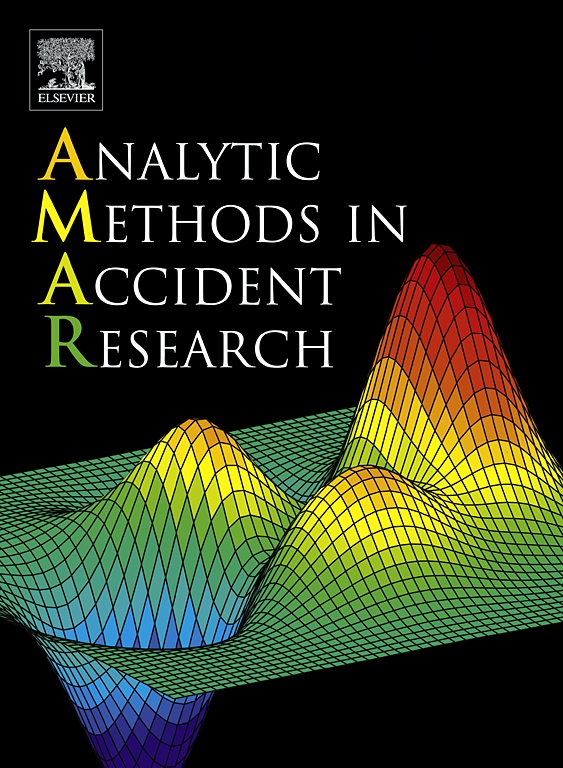基于分层空间分辨率的交通事故建模统一框架
IF 12.6
1区 工程技术
Q1 PUBLIC, ENVIRONMENTAL & OCCUPATIONAL HEALTH
引用次数: 0
摘要
独立的交通碰撞建模方法没有考虑到与多分辨率数据结构相关的嵌入式关系,导致错误的估计。最近开发的集成框架展示了解决这一缺陷的能力。目前的研究提出了一个集成框架,可以容纳来自多个空间单元和观测分辨率的信息。具体而言,该研究开发了一个综合模型系统,该模型系统允许在宏观倾向估计中同时考虑来自分解碰撞记录、微观设施(路段和交叉口)和宏观(交通分析区)层面的自变量的影响。实证分析考虑了佛罗里达州奥兰多市300个交通分析区1818个路段和4184个交叉路口的分类碰撞记录。这些碰撞记录包含每个碰撞记录的特定碰撞因素、驾驶员和车辆因素、道路、道路环境和天气信息。对于微观设施和宏观层面,考虑了一组详尽的自变量,包括道路和交通因素、土地利用和建筑环境属性以及社会人口特征。所提出的模型系统还可以适应不同观测分辨率的数据之间的层次相关性和整个系统的参数可变性。通过采用几个拟合优度和预测度量来增强实证分析。结果清楚地表明,与非集成模型相比,所提出的集成模型系统提供了更好的性能。验证练习也突出了所建议框架的优越性。应用拟议的综合框架可以使交通专业人员同时采用基于政策、特定地点和特定结果的解决方案。本文章由计算机程序翻译,如有差异,请以英文原文为准。
A unified framework for modeling traffic crashes from hierarchical spatial resolutions
Independent traffic crash modeling approaches do not account for the embedded relationships related to the multi-resolution data structure, leading to mis-specified estimations. The recently developed integrated frameworks demonstrate the capability of addressing this drawback. The current study proposes an integrated framework that accommodates information from multiple spatial units and observation resolutions. Specifically, the study develops an integrated model system that allows for the influence of independent variables from disaggregate crash record, micro-facility (segment and intersection) and macro (traffic analysis zone) level simultaneously within the macro level propensity estimation. The empirical analysis considers disaggregate crash records of 1818 segments and 4184 intersections from 300 traffic analysis zones in the City of Orlando, Florida. These crash records contain crash-specific factors, driver and vehicle factors, roadway, road environmental and weather information of each crash record. For micro-facility and macro levels, an exhaustive set of independent variables including roadway and traffic factors, land-use and built environment attributes, and sociodemographic characteristics are considered. The proposed model system can also accommodate for hierarchical correlations among the data across observation resolutions and parameter variability across the system. The empirical analysis is augmented by employing several goodness of fit and predictive measures. The results clearly demonstrate the improved performance offered by the proposed integrated model system relative to the non-integrated model. A validation exercise also highlights the superiority of the proposed framework. The application of the proposed integrated framework can allow transportation professionals to adopt policy-based, site-specific, and outcome-specific solutions simultaneously.
求助全文
通过发布文献求助,成功后即可免费获取论文全文。
去求助
来源期刊

Analytic Methods in Accident Research
Multiple-
CiteScore
22.10
自引率
34.10%
发文量
35
审稿时长
24 days
期刊介绍:
Analytic Methods in Accident Research is a journal that publishes articles related to the development and application of advanced statistical and econometric methods in studying vehicle crashes and other accidents. The journal aims to demonstrate how these innovative approaches can provide new insights into the factors influencing the occurrence and severity of accidents, thereby offering guidance for implementing appropriate preventive measures. While the journal primarily focuses on the analytic approach, it also accepts articles covering various aspects of transportation safety (such as road, pedestrian, air, rail, and water safety), construction safety, and other areas where human behavior, machine failures, or system failures lead to property damage or bodily harm.
 求助内容:
求助内容: 应助结果提醒方式:
应助结果提醒方式:


